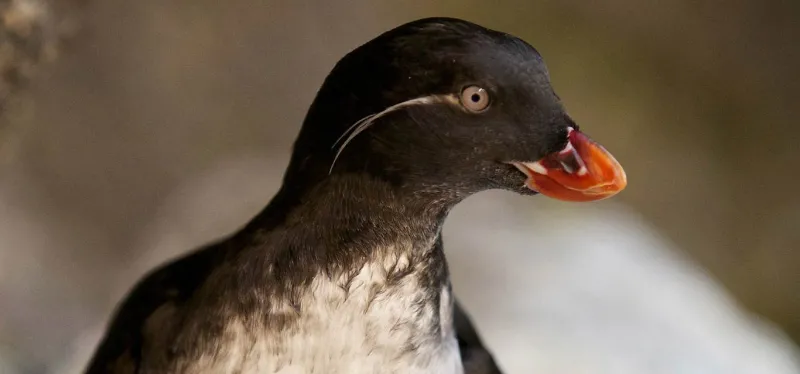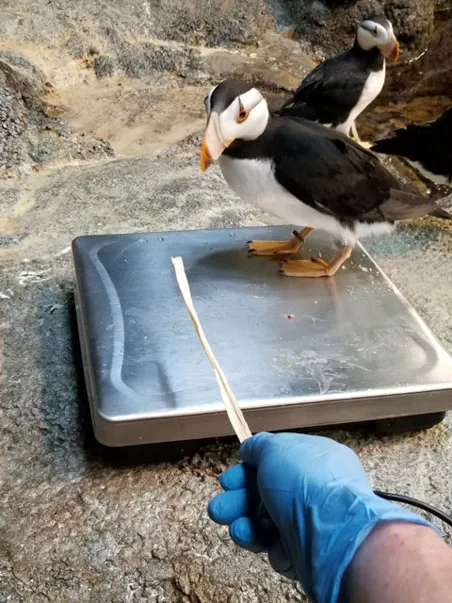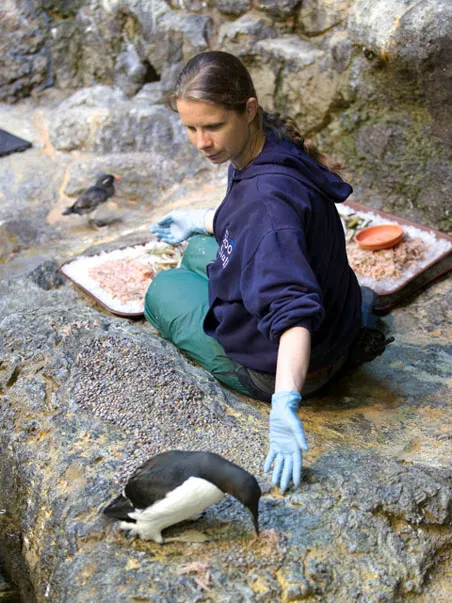Written by Sarah McCrory, Zookeeper, North Carolina Zoo
Have you ever thought about what it would take to care for 39 seabirds?
There are many pieces of the puzzle when it comes to caring for them, such as how is their habitat cleaned? What do they eat? What do they like for enrichment?
Let's start with who is in the seabird habitat. There are three species of seabirds: thick-billed murres, horned puffins, and parakeet auklets. All are found in the Arctic region. The murre is the largest species and is often confused with a penguin due to the black and white plumage coloration and upright stance. The puffin is medium-sized and has a white face, orange and cream-colored bill, and fleshly little horns above their eyes. In the winter, their face and bill are generally darker in color, and the fleshy horn shrinks to the point that can barely be seen. The auklet is the smallest bird in the habitat. They have a uniquely shaped orange bill that helps them feed on small fish, jellyfish, and zooplankton.

Parakeet auklet
The seabird habitat is indoors. We keep it cool year-round for these arctic birds. The air temperature averages 52 degrees Fahrenheit and the water temperature averages 60 degrees Fahrenheit year-round. The pool is 10 feet deep and holds 44,000 gallons of water. Guests can observe the birds as they dive for food using their wings to propel themselves through the water. Zookeepers clean this cold habitat every morning and do a light hosing in the afternoon. The birds are fed twice per day. Some food is offered on iced trays left in the habitat for the birds to feed on at their leisure. Zookeepers will also toss fish into the pool to simulate the birds' natural foraging behavior.
Picture Above: Horned puffins
Zookeepers routinely scuba dive this pool to clean up any fish that the birds haven't eaten. Feeding time is also a good time for observing the birds make sure all of the birds are behaving normally.
There are a couple of ways we monitor the health of the birds. One is during observations throughout the day. Another is training the birds to get weighed on a scale and get an up-close look at them. A couple of times a week, a scale is brought into the habitat. Some of the birds are eager to get on the scale as they know that they will either get fish or nesting materials: others it has taken time, patience, and a lot of trust-building.

A horned puffin training to step on a scale
Enrichment is given almost daily to the seabirds. What we give them is based on what natural behaviors we want to see.
These birds elicit behaviors like swimming, diving, foraging, and cavity searching, amongst many others. We have made calendars that tell us which behaviors we want to see and what enrichment items are available to us. When we put the items in the habitat, we watch which birds are using the items and note if the behavior they are eliciting is the goal behavior for the day. Then the information we collect goes into a spreadsheet for us to analyze. The data can tell us over time if an item is useful in eliciting the goal behavior. If it does, great! We've achieved our goal! If not, we will modify the item and try again. Or sometimes, we start from scratch.

Zookeeper Sarah McCrory and a thick-billed murre
I hope you enjoyed learning a little about how to care for the seabirds.


